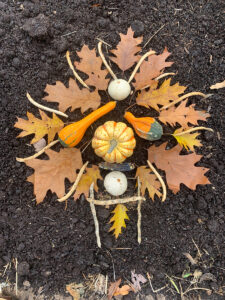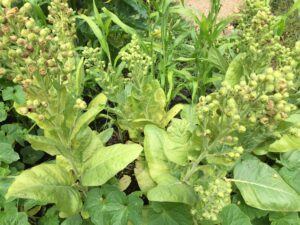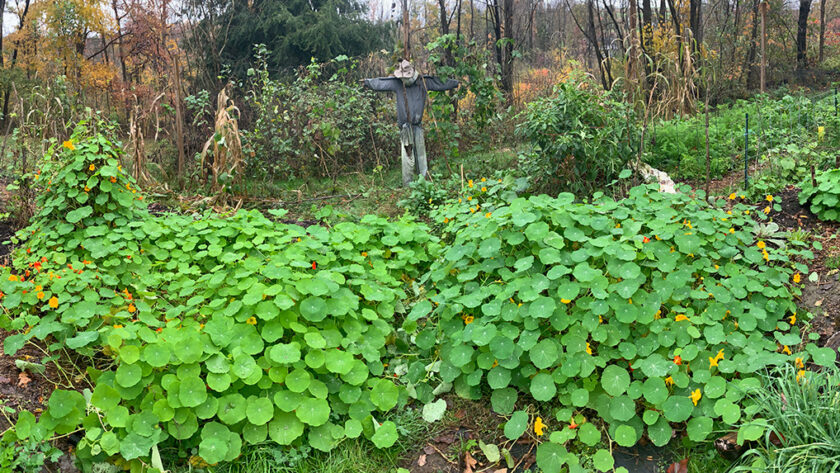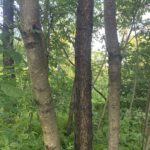A person walks into a garden at as the sun rises. As it is the spring equinox, the soil is still mostly bare, although the stinging nettles are peeking through the earth to enjoy the first of the morning rays. They begin with a slow chant to raise the sun, just as the sun begins to peek over the horizon. As the first rays of light hit the fallow garden, they raise their hands to the air and ask for a blessing from the sun upon the land. They draws down the energy of the sun, shaping it into protective patterns throughout the garden. He makes offerings at several shrines and then they place their hands on the soil and listen to the voice of the land. All is well and the new season will soon be present–the spirits of the soil are ready and waiting.

In my series on animism, we’ve been exploring what animism is as a spiritual philosophy and practice, and how we can deeply engage in the world around us using animistic philosophy in our gardens, lives, and more. In my larger series on animism, we’ve been exploring what this spiritual philosophy looks like, and how it might apply to life: introduction to animism, co-creating intentions with nature, animism and permaculture introduction and ethics, connecting to the Genius Loci (spirit of place), and addressing waste. I’ve been recently exploring animism applied to gardening, through a three-part series on philosophy: animistic gardening and its philosophies (Part I), practice: animistic gardening (part II: gardening strategies and today’s post, rituals and ceremonies, which wraps up the series on gardening by exploring garden rituals and metaphysical work with the spirits of the garden.
The Animsitic Garden’s Rituals and Practices: Spontaneous, Flexible, Connected
In my experience, an animistic approach to ritual works a little differently than other kinds of rituals you might do as part of a larger tradition. When we think of rituals we often think of things that are highly scripted and formal. Formal rituals have their place and can be very effective, but the rituals I do in my garden as part of my animistic practice with the spirits are really quite different.
When I’m thinking about rituals and ceremonies working with the spirits of the land, I recognize that these practices are co-created with spirits. Thus, they are often flexible, they may be spontaneous, and they don’t necessarily have a lot of scripts, special outfits, or anything else. I’m most likely to be in my gardening overalls and muck boots performing this kind of ceremony than down in our outdoor grove wearing elaborate clothing and using special tools.
I also think a lot of rituals that I do in the garden are co-created and emerge spontaneously as I work. For example, recently I’ve been spending a good deal of time working on the beds in the fall to prep them for next season. I put my hand on the soil and ask what is needed. The soil web responds to me telling me to sing a song for slumber while I work. So I sing to the soil as I am working, bringing the energy of slumber into the thick earth, drawing sigils and humming. Or recently, I was harvesting gourds and transitioning our greenhouse from summer crops to winter crops as the temperatures were dropping significantly. I honored the plants that were being removed with offerings and then moved them to the compost pile. When I got to the compost pile, the pile responded that it was doing well but after adding all of the additional materials, the pile was large enough and wanted to rest for the winter season–any additional materials had to go in a new pile. So I again made an offering and sang a song of slumber, adding straw from my duck coop that needed to be cleared out, also tracing a sigil for sleep that I developed as part of my land healing work.
This isn’t to say that I don’t do more formal rituals as part of my garden, but a lot of ceremonies and practices work just like the stories I’ve shared–things that arise as I am already tending the space. They are interwoven and happen as a response to ongoing communication, conversation, and collaboration with spirits. There are some specific rituals that I find useful to do, so I’ll also share these here.
Ritual for Honoring the Soil Web of Life
Other than the sun, warmth, and rain, the soil web of life is one of the critical parts of any garden. Most gardeners who have been growing food for any amount of time recognize that one of the things we are growing–the most important thing we are growing–is soil. A healthy soil web creates strong plants and can deter disease and pests and provide nutrient-dense food. A dead soil web needs to be amended with fossil fuel fertilizers and the topsoil washes away. Thus, I like to honor the soil web as part of my regular cycle of rituals each year.

My soil web ritual usually takes place during the time when I’m tending the soil and doing bed prep at the end of the season. In our gardens, we usually remove the annual garden material in the fall to prevent disease and pest buildup and leave all the perennial plants as they are so that insects have a place to rest and hide for the winter. So to our annual beds, we add compost, cut out old and dead plants, and prepare the beds for rest in the winter (or planting garlic, or cover crops).
As part of my soil web honoring, most often, as I am working to clear the annual beds in the fall, I will create a mandala for each big bed–the mandala can be anything that will break down effectively into the bed: leaves, gourds, sticks, nuts, or seeds. Whatever I put there, I leave there, and sometimes that means a gourd or someone else will grow from the mandala–so do keep that in mind! The image here came from last year–I used dried beans, oak leaves, and some small gourds and pumpkins we grew. This year, we had new little white gourds from where this mandala had been–and they will be once again added into the mandala…and will likely return to another part of the garden. These simple garden mandalas can be infused with love and respect, as you create them, radiate your gratitude and well wishes for a good rest during the fallow period. Once the mandala is completed, I also perform the AODA’s Sphere of Protection ritual around the bed–this keeps the bed protected and safe as it is tucked in for the winter months. I may do other things too, as spirits lead me–but that’s the core I do each year.
You can speak to your soil web about any needs the web has. Make it a point to communicate regularly with the soil, listen, and learn.
Honoring Your Tools
If you’ve tended any kind of garden space before, you know how important your tools are. And with an animisic philosophy, recognize, your tools are people too! Gloves to keep your hands undamaged; a good wheelbarrow to help you move soil and other garden materials; good hand tools such as a shovel, rake, hoe, garden fork, and pitchfork; and specialized and special tools like your broadfork for aerating soil and reducing compaction. These tools are integral to the work you do every day, and it is thus important to honor them and recognize them as individuals.
Honoring your tools has two levels, metaphysical and physical. On the physical level, cleaning your tools after use, putting them back in a dry place, and even brushing them off to ensure they are clean are all ways of making sure that they will last a long time. This allows you to recognize that your tools are important and worthy of your care. Metaphysically, when I put my tools away, I also like to thank them for their help with my gardening tasks. If I get a new tool, I welcome the tool to the land.
I don’t have any larger rituals for honoring my tools, usually, I just offer gratitude. I do check in with them to see if they have what they need to be fulfilled and do their best work.
Song, Dance, and Storytelling

One of the ways you can think about your garden and the spirits there is like they are another part of your family–what do you do to interact with them on a regular basis? How do you build and maintain those relationships? I like to be metaphysically present, not just physically present, when I am in the garden. I find that songs, storytelling, and even dancing can help make this connection stronger.
Thus, I find it to be fun to hear the stories of the garden–what does the garden want to share with me? What do I want to share with the garden? I may also sing, dance, and meditate in the space. I make up songs for planting and harvest or even just hum a tune for the spirits. These can really be anything you wish them to be–and trust me, I’m not a great singer! But it doesn’t matter, what matters is that you are putting the energy and enthusiasm forth. The goal of these things is to make sure you are present and honoring not only the physical space but the metaphysical presence of spirits.
Welcoming Ceremony
Any plants, animals, tools, seeds, finished compost–pretty much anything that I am bringing in from outside of our land gets a welcome. When they arrive, I treat them respectfully, showing them around the property and telling them what we do here. I make sure to let the seed/tool/plant know that they are very welcome here and if they need anything, they just need to ask. I also make a simple offering. When I do my daily Sphere of Protection, I make sure they are included and honored.
Establishing Ritual Cycles
I recommend that you establish some yearly rituals on behalf of your garden–these should be rituals of protection, abundance, and blessing. Build this into your yearly cycle of seasonal rituals so that you always have things you do for your garden. Two such rituals we do each year are the Butzemann ritual and Wassailing on behalf of the garden.
The Butzemann (more details in my post), ritual is a protective garden ritual that spans the entire growing season–this is where we create and bring to life a magical scarecrow in order to protect the land for the course of the season. The Butzemann is ritually burned at Samhain as the land goes into slumber, then created anew between Imbolc and the Spring Equinox–always from material from last year’s garden.
We also wassail our trees in our garden and generally speaking, the perennial plants. Wassailing is an old tradition that helps support the abundance and vitality of the living earth. Wassailing takes place in January when you are also tending and pruning your fruit trees.
A final ceremony I do is daily protective work on behalf of the land. AODA uses the Sphere of Protection ceremony–the SOP is done either on yourself or can be done on a larger landscape. If I’m staying on the land throughout the day, I do the SOP on the land itself, protecting the gardens, our flocks, and the wild areas of the property. flocks. I reinforce the existing protections each day I do the SOP in this way. If I am leaving the home (usually about 3 days a week with my job), I will protect myself that day, but also extend the protection to the land and gardens. I always do this ceremony as the sun is rising in the morning and after I tend our flocks. This daily protective ritual ensures that the protections on the land are always strong.
Conclusion
I hope that this post has given you some new ideas for how you might metaphysically interact with the spirits of your garden–both individual plant or insect spirits as well as the larger spirits of place (Genius Loci) or the soil web of all life. I would love to hear what you do to spiritually connect with the spirits in your garden–please do share!




could you link to more on the Sphere of Protection please? Can’t find it
Sure, here’s a link! https://aoda.org/publications/articles-on-druidry/introduction-to-the-sphere-of-protection/
I am impressed by your account and concern with the spirits of nature.
Being involved in metaphysics as a member of The Aetherius Society, I invite you to check my website.
In the 5th. Blessing of TheTwelve Blessings recorded in the words of Jesus through MasterYogi and Cosmic Adept Dr.George King, mention is made about the Devic Kingdom.
Working with the spirits of the land and plants is new to me. Are all the spirits “good”? Are some “not good”? What is it that we are protecting ourselves from during the protection rituals? Thank you.
Hi Joanne,
Yes, the spirit world is as complex as a the human world, and like humans, spirits have different motivations. I don’t know if I like the terms good and evil, that seems very binary. But spirits can have motivations that align with helping humans or harming them, and like people, those change over time. Even spirits of nature many not always be good or of the light. So yes, we protect ourselves from that which may seek to harm or mislead us; protection is one of the first skills to learn when engaging in spirit work.